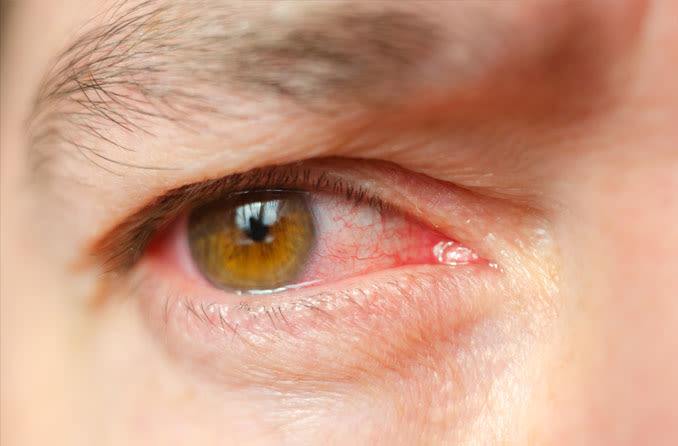Eye infections: Causes, symptoms and treatment

Do I have an eye infection?
An eye infection can happen when bacteria, viruses or fungi invade part of the eye or its surrounding area. This includes the clear front surface of the eye (cornea) and the thin, moist membrane lining the outer eye and inner eyelids (conjunctiva).
Many eye infections go away on their own or with simple treatment. Less commonly, an eye infection can be very serious and require immediate medical attention.
Eye infection symptoms
The symptoms of an eye infection depend on the underlying cause and can include:
Eye pain
Watery eyes
Swelling around the eyes
Itching
Anytime you suspect an eye infection, you should always visit an eye doctor. Trying to self-diagnose your condition can delay treatment and, in rare cases, even threaten your vision.
If you experience eye infection symptoms and wear contact lenses, take your contacts out and wear eyeglasses until a doctor can diagnose your condition.
Causes and types of eye infections
Common eye infections include:
Pink eye
One of the most common types of eye infection is conjunctivitis, more commonly known as pink eye.
Pink eye is a very contagious eye infection often spread among children in day care centers, classrooms and similar environments. Teachers and day care workers have an increased risk of pink eye when they work in close quarters with young children.
Infectious conjunctivitis types are often viral or bacterial. Infants can acquire conjunctival eye infections (gonococcal and chlamydial conjunctivitis) during birth when a mother has a sexually transmitted disease.
Besides common pink eye, other viral eye infections include ocular herpes, which occurs with exposure to the Herpes simplex virus.
Stye
A stye is a common infection that causes a tender, red bump on the edge of the eyelid.
Styes happen when something blocks an eyelid oil gland, leading to a small, but uncomfortable, bacterial infection. Most styes can be treated using basic home remedies. In less common situations, they can require medical attention.
A chalazion and a stye are easy to confuse. However, unlike a stye, a chalazion is painless, is not a bacterial infection, and usually occurs further away from the edge of the eyelid.
Fungal keratitis
Fungal keratitis is a fungal eye infection made worldwide news in 2006 when a contact lens solution was linked to an outbreak among contact lens wearers. The solution is no longer on the market.
The outbreak was associated with the fungi Fusarium, often found in organic matter. This and other fungi can invade the eye in other ways, such as a penetrating injury caused by a tree branch.
Acanthamoeba keratitis
Contact lens wearers are at increased risk of encountering parasites that can invade the eye and cause a serious sight-threatening infection called Acanthamoeba keratitis.
This is why contact lens wearers should observe certain safety tips, like avoiding swimming while wearing contacts. Proper contact lens care must be followed to minimize the risk of all types of infection.
FDA guidelines recommend that manufacturers include a discard date (not just a date of expiration) on contact lens cleaning and disinfecting products to help minimize the risk of an eye infection.
Trachoma
While uncommon in the United States, the eye infection known as trachoma is so widespread in some underdeveloped regions that it's a leading cause of blindness. Flies can spread the infection in certain environments, and reinfection is a common problem.
Trachoma usually infects the inner eyelid, which starts to scar. Scarring then causes an "in-turning" of the eyelid, and eyelashes begin to brush against — and destroy — tissue on the cornea, resulting in permanent blindness.
Good hygiene and the availability of medical treatment like oral antibiotics are essential to controlling trachoma.
Endophthalmitis
When an eye infection penetrates the inside of the eye, as with bacterial endophthalmitis, blindness can occur without immediate treatment — which usually includes strong antibiotics.
This type of infection can happen after a serious eye injury or as a rare complication of an eye surgery, such as cataract surgery. Whenever an eye injury penetrates the eyeball, there is a 4% to 8% risk of endophthalmitis.
Mold can also cause endophthalmitis. Most of these cases are reported in tropical regions.
SEE RELATED: Other types of keratitis
Possible complications
Some eye infections can lead to further complications, especially when they're left untreated.
When an infection moves to the eye's tear glands, inflammatory conditions such as dacryostenosis and uveitis can occur. Infection can also lead to inflammation and blockage of the eye's tear drainage system and cause dacryocystitis.
Infection can be an underlying cause of a corneal ulcer, which resembles an abscess on the eye. If left untreated, a corneal ulcer can lead to severe vision loss.
More serious eye infections can eventually penetrate the deeper, inner portions of the eye to create sight-threatening conditions such as endophthalmitis.
With orbital cellulitis, infection in and around the soft tissue of the eyelids is a medical emergency, since the condition can spread without quick treatment.
Eye infection treatment
There are many different types of eye infections, and your eye doctor needs to diagnose your particular infection to prescribe the best treatment.
Your doctor may take a sample from the affected area for a culture. This helps them assess the exact type of infection you have, if any. With this information, they can determine the most effective treatment, such as an antibiotic that selectively targets the type of bacteria causing the infection.
Fortunately, many common viral eye infections get better on their own, but severe viral eye infections may need antiviral eye drops to heal. Other viral infections require a careful administration of steroid eye drops to reduce related inflammation.
Most common bacterial eye infections clear up with prompt treatment, which can include:
Prescription antibiotic eye drops
Prescription antibiotic ointments
Eye compresses
Depending on the underlying cause of your eye infection, your doctor might prescribe oral antibiotics or antiviral medications, in addition to other treatments.
If your symptoms worsen or change, contact your eye doctor immediately.
SEE RELATED: Artificial tears solution
How to prevent eye infections
If you're close to a person with one or two red eyes, avoid touching the area around your eyes until you can wash your hands first.

Prevent eye infections by washing your hands before touching your eyes or eyelids and before handling contact lenses.
You can minimize the risk of catching common bacterial or viral eye infections by using anti-infective sprays and cleansers in public areas, including day care centers and classrooms.
In general, it's good to teach children to avoid touching their eyes without washing their hands first.
At home, if any family members have a red eye or a confirmed eye infection:
Keep their bedding and towels clean
Don't let them share these items with anyone else
Have them wash their hands often
If you wear contact lenses, follow the safety tips for good hygiene, including washing your hands before you touch your contacts.
Stay aware that sleeping while wearing contacts, even "breathable" silicone hydrogel contact lenses approved for overnight wear, can significantly increase your risk of eye infection.
Adam Debrowski and Marilyn Haddrill also contributed to this article.
Endophthalmitis after open globe injuries. American Journal of Ophthalmology. April 2009.
Polymerase chain reaction analysis of aqueous and vitreous specimens in the diagnosis of posterior segment infectious uveitis. American Journal of Ophthalmology. January 2009.
Periorbital and orbital infections. Infectious Disease Clinics of North America. June 2007.
Endophthalmitis categories. Principles and Practice of Infectious Diseases, 6th ed. 2004.
Eye infections in the tropics. Cohen & Powderly: Infectious Diseases, 2nd ed. 2004.
Infections of the lacrimal system.Principles and Practice of Infectious Diseases, 6th ed. 2004.
Page published on Wednesday, February 27, 2019






